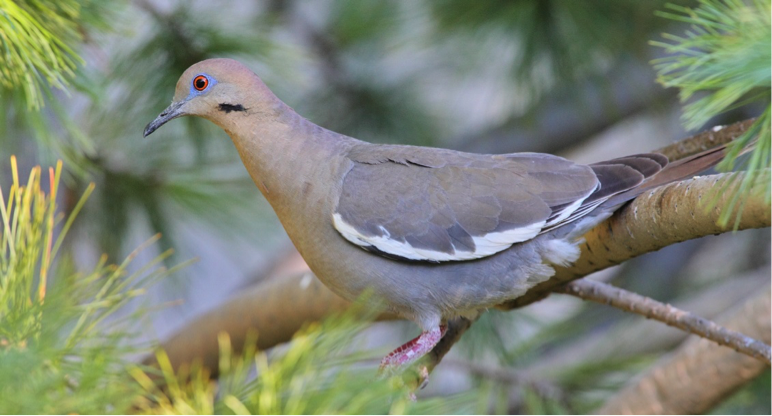by Bob Walker
The White-winged Dove (Zenaida asiatica) is another common dove found year-round in Los Alamos County. Originally a game bird of Mexico and the southern USA, it has been expanding its range northward, and in the last ten years there have been eBird reports of White-winged Doves all the way to the US-Canadian border; their heaviest population center is in central Texas. The bird is considered to be migratory over a large part of its range, but it is likely that there are resident populations where the food supply is stable (for example, our back yard feeders). Los Alamos County eBird reports show the bird ranging in altitude from the Rio Grande River all the way to Pajarito Mountain. Many birders express concern that the expansion of White-winged Doves northward is at the expense of what were originally more common Mourning Doves.
Named for the obvious white lining on their wing margin, White-winged Doves also have bright red eyes on a pastel blue background, and a black patch below the eye; they are slightly smaller and slimmer than Eurasian Collared-Doves. They feed prolifically on seed, both on the ground and from elevated feeders, and will feed in large flocks, wiping out back yard feeders in a matter of minutes. In desert environments, they will feed on nectar, pollen, and saguaro cactus fruits as well.
The four-note phrase in the morning song of the White-winged Dove is also quite recognizable, and is often likened to the catchphrase “who cooks for you?” Listen below to the White-winged Dove, and compare with last week’s Eurasian Collared-Dove, and see if you can tell the difference.
Find more detailed articles about White-winged Doves on these web pages: identify.whatbird.com and allaboutbirds.org. You can see beautiful photos of White-winged Doves at the Glenn Bartley and Alan Murphy web sites. For even more images, perform an image search on Google or Flickr, and you’ll find many good photographs.

